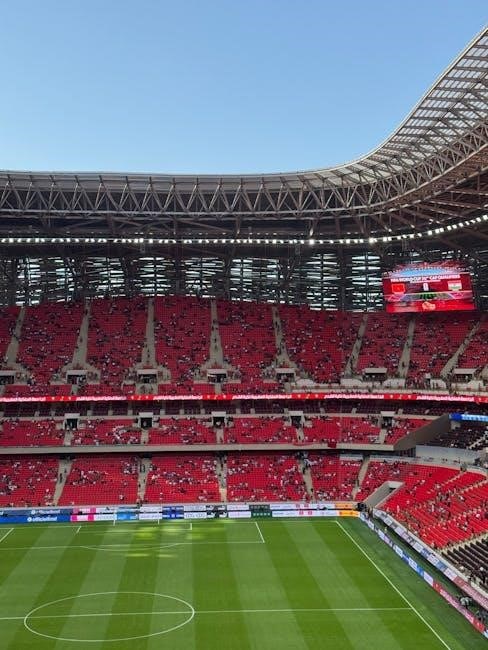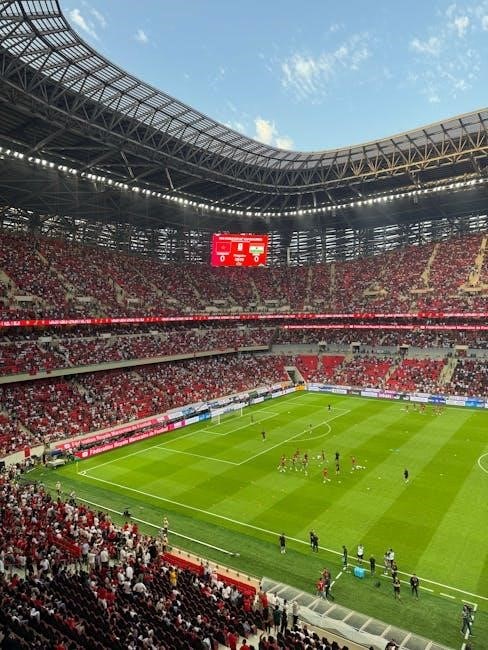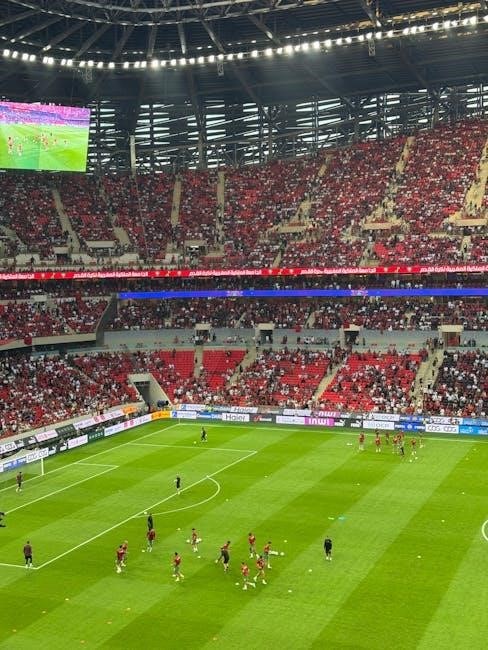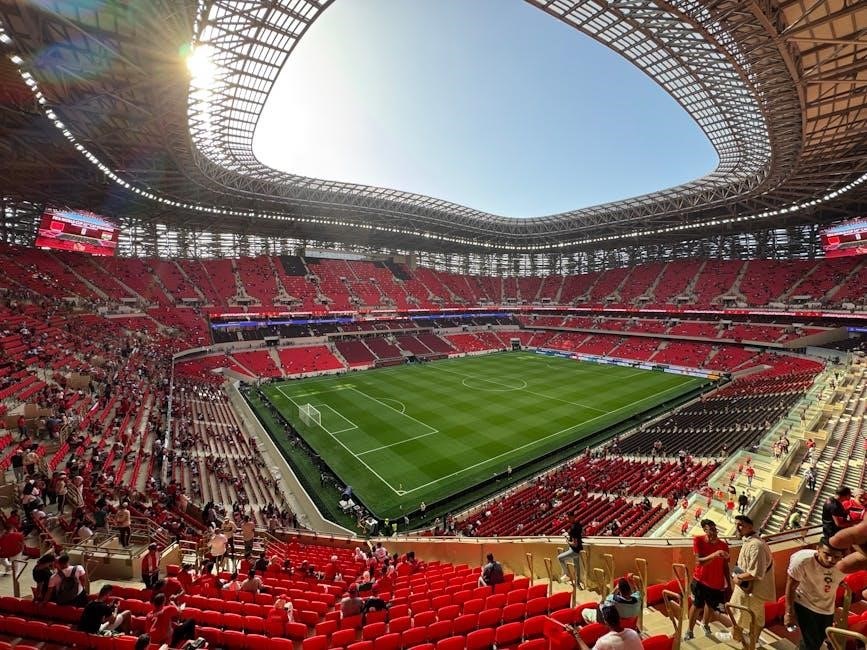
spotkick game dimensions pdf
Spotkick, a popular spot-kick game, emphasizes precise field dimensions and strategic gameplay. Its structure requires standardized field sizes, markings, and goal dimensions to ensure fair competition and optimal performance.
Overview of the Spotkick Game
The Spotkick game is a dynamic and strategic sport that revolves around precision and skill. Played on a standardized field, it involves penalty kicks, where players aim to score by kicking the ball into the opponent’s goal. The game emphasizes field dimensions, markings, and goal sizes, ensuring fairness and consistency across matches. Key elements include the penalty area, spot-kick spot, and goal dimensions, which are crucial for gameplay. Players employ offensive and defensive strategies, while goalkeepers use specialized techniques to block shots. The game also involves psychological aspects, such as player focus and crowd influence, adding depth to its competitive nature.
Importance of Field Dimensions in Spotkick
Field dimensions in Spotkick are crucial for ensuring fair play and competitive balance. Standardized measurements guarantee uniformity across matches, allowing players to strategize effectively. The size of the field, penalty area, and goal dimensions directly impact gameplay dynamics, influencing both offensive and defensive tactics. Accurate markings, such as the center circle and penalty spot, ensure clarity and consistency in rule application. Proper field dimensions also enhance player safety and performance, as they provide a clear framework for movement and interaction. Without standardized dimensions, the game would lose its competitive integrity and strategic depth, making it less engaging for participants and spectators alike.
Historical Background of Spotkick
Spotkick, a strategic football variant, has roots tied to penal fouls and shootouts. Its evolution traces back to early football rules, emphasizing precision and skill in penalty kicks.
Origins of the Spotkick Game
Spotkick, a variant of football, traces its origins to penalty shootouts in traditional football. Emerging in the early 20th century, it gained popularity as a decisive method for breaking ties. The game emphasizes precision and strategy, with players aiming to score from a designated spot. Historical records show its evolution from informal matches to structured competitions. The Spotkick game dimensions, including field markings and goal sizes, were standardized to ensure fairness. Its rise reflects the cultural and competitive aspects of football, becoming a focal point in tournaments worldwide. Today, Spotkick remains a thrilling spectacle, blending skill, psychology, and teamwork.
Evolution of Field Markings in Spotkick
The evolution of field markings in Spotkick reflects advancements in standardization and gameplay clarity. Early iterations lacked formalized markings, leading to inconsistencies. Modern Spotkick features precisely defined field dimensions, including penalty spots, goal lines, and center circles. These markings ensure fairness and accuracy in scoring decisions. Over time, the introduction of technologies like VAR has reinforced the importance of clear field markings. The standardized dimensions and markings have become integral to the game’s structure, enabling players and referees to perform their roles effectively. This evolution underscores the game’s commitment to precision and transparency, enhancing its global appeal and competitive integrity.

Field Dimensions in Spotkick
Field dimensions in Spotkick are crucial for maintaining gameplay consistency and fairness. They include standardized measurements for the entire field, penalty areas, and goal sizes, ensuring clarity and precision in matches.
Standard Field Size for Spotkick
The standard field size for Spotkick is designed to ensure consistency and fairness in gameplay. The field typically measures 100-110 meters in length and 64-75 meters in width, providing ample space for players to maneuver while maintaining the intensity of penalty-focused competition. These dimensions are slightly smaller than a full-sized football field, emphasizing the strategic nature of spot-kicks. The field’s markings, including the center circle and penalty spots, are meticulously defined to guarantee clarity for players and referees alike; This standardized approach ensures that all participants compete under equal conditions, fostering a balanced and competitive environment.
Dimensions of the Penalty Area
The penalty area in Spotkick is a critical component of the game, designed to provide a clear and fair space for penalty kicks. The standard dimensions of the penalty area are 16.5 meters (54 feet) in width and 16.5 meters in length, forming a square. These measurements ensure consistency across all matches, allowing players to understand the playing field accurately. The penalty area is marked distinctly to highlight the spot where penalty kicks are taken, 12 meters (39.37 feet) from the goal line. This standardized size enhances the game’s structure, ensuring fairness and strategic play during penalty situations.
Goal Dimensions in Spotkick

The goal dimensions in Spotkick are standardized to ensure consistency and fairness. The goal frame is typically 8 feet (2.44 meters) in height and 24 feet (7.32 meters) in width. These measurements are crucial for maintaining the integrity of the game, as they provide a clear target for players during penalty kicks and open play. The goal’s size also plays a significant role in the game’s strategy, as it influences both offensive and defensive tactics. The standardization of goal dimensions ensures that all players compete on an equal footing, regardless of the field or tournament.

Field Markings in Spotkick
Field markings in Spotkick are essential for gameplay structure, including the center circle, penalty spots, and boundary lines. These markings ensure standardized gameplay and fairness.
Center Circle and Its Significance
The center circle in Spotkick is a critical marking with a diameter of 9.15 meters, serving as the starting point for kick-offs and restarts. It ensures fair play by providing a clear area for players to gather and begin gameplay. The circle’s design helps maintain order during initial phases, preventing chaos and ensuring adherence to rules. Additionally, it plays a strategic role in formations and set-pieces, allowing teams to organize effectively. The center circle’s precise dimensions and placement are vital for maintaining consistency and fairness across all matches, making it an essential element of the game’s structure and flow.
Penalty Spot and Its Role
The penalty spot in Spotkick is a small circle with a diameter of 0.5 meters, positioned 11 meters from the goal line. It serves as the designated area for penalty kicks, ensuring fairness and consistency in critical moments. The spot’s precise location and size are crucial for maintaining the integrity of the game, as it provides a clear and standardized point for players to take penalties. The visibility of the spot, often marked in white, ensures it stands out for players, referees, and spectators alike. Its role is central to resolving fouls and maintaining the game’s balance, making it a key element in Spotkick’s structure.
Other Key Markings on the Field
Besides the center circle and penalty spot, Spotkick fields feature several other essential markings. The corner arcs, each with a radius of 1 meter, are positioned at each corner of the field to indicate where corner kicks are taken. Additionally, the halfway line divides the field into two equal halves, clearly marking the boundary for restarts and substitutions. The substitution area, often marked near the halfway line, designates where players can enter or exit the game. These markings ensure clarity and organization, enabling smooth gameplay and adherence to rules. Their precise dimensions and placements are vital for maintaining the game’s structure and integrity.
Rules and Regulations of Spotkick
Spotkick games last 60 minutes, divided into two 30-minute halves. A size 5 ball is used, with seven players per team, including a goalkeeper. Fouls result in free or penalty kicks, decided by referees.
Basic Rules Governing the Game
The objective of Spotkick is to score by kicking the ball into the opponent’s goal. Matches last 60 minutes, divided into two 30-minute halves. A size 5 ball is used, and each team fields seven players, including a goalkeeper. Players can use any part of their body except hands and arms. Substitutions are allowed during stoppages. Fouls result in free or penalty kicks, with referees enforcing rules to ensure fair play. Offside rules apply to maintain attacking fairness. The team with the most goals at the final whistle wins, promoting skill, strategy, and sportsmanship in this fast-paced, tactical game.
Specific Rules for Penalty Kicks
A penalty kick is awarded when a foul occurs inside the penalty area. The ball must be placed on the penalty spot, 12 yards from the goal line. The goalkeeper must remain on the goal line, between the posts, until the ball is kicked. The kicker can only touch the ball once, and feinting to deceive the goalkeeper is prohibited. Players from both teams must stay outside the penalty area until the ball is kicked. If the ball crosses the goal line, a goal is awarded. Infringements by any player result in a retake or a penalty for the opposing team.

Strategies and Tactics in Spotkick
Strategies involve positioning, psychological tactics, and team coordination. Teams analyze opponents to anticipate moves, while players practice precise shooting and saving techniques to outperform rivals.
Offensive Strategies in Spotkick
Offensive strategies in Spotkick focus on maximizing scoring opportunities. Players often position themselves strategically within the field dimensions, leveraging the penalty area’s size to create angles. Dribbling and quick passes are used to outmaneuver defenders, while shooters aim for corners to increase chances of scoring. Psychological tactics, such as feints and body language, are employed to deceive goalkeepers. Teams also analyze opponents’ weaknesses, such as a goalkeeper’s tendency to dive early or favor a side. Coordination between attackers is crucial, with players creating distractions or fake shots to disrupt the defense. These tactics are refined during practice to adapt to field dimensions and opponent behavior.
Defensive Tactics in Spotkick
Defensive tactics in Spotkick emphasize anticipation and positioning to minimize scoring chances. Goalkeepers study shooters’ tendencies to predict kick directions, leveraging the field’s dimensions to their advantage. Defenders align themselves strategically within the penalty area, reducing shooting angles and forcing shooters into less favorable positions. Quick reflexes and agility are crucial for reacting to fast-paced plays. Teams often employ a “guesstimate” approach, where goalkeepers make split-second decisions to dive left, right, or stay centered. Additionally, defenders may use psychological tactics, such as staring down the shooter, to create doubt. The compact field dimensions amplify the effectiveness of these defensive strategies.

Psychological Aspects of Spotkick
Spotkick’s high-pressure environment tests players’ mental toughness, focus, and composure, often influencing decision-making and performance under intense scrutiny.
Player Psychology in Penalty Situations
Player psychology in penalty situations is crucial, as the pressure to score or save can significantly impact performance. The mental battle between the taker and goalkeeper often defines outcomes. Confidence, focus, and composure are key traits for success. Players may employ strategies like visualization or rituals to maintain calm under pressure. The dimensions of the field, particularly the penalty spot distance, can influence a player’s mindset, as accuracy and precision are vital. Experience and practice play a significant role in building psychological resilience. Additionally, opponents may use tactics like distraction to unsettle players, further highlighting the psychological complexity of these high-stakes moments.
Impact of Crowd on Player Performance
The crowd plays a significant role in shaping player performance during Spotkick. A supportive home crowd can boost morale, while a hostile away crowd can create pressure. Noise levels can disrupt communication and focus, potentially leading to errors or hesitation. Players may feel energized by cheering fans, enhancing their determination, but excessive pressure can cause anxiety; The psychological impact of a crowd’s expectations often influences decision-making and accuracy. Additionally, the atmosphere can affect referees’ decisions, indirectly impacting the game. Overall, the crowd’s presence adds an emotional layer to the game, making it a critical factor in player performance and outcomes.

Technology in Spotkick
Technology enhances accuracy and fairness in Spotkick, with tools like VAR ensuring correct decisions and wearable devices tracking player performance efficiently during matches.
Role of VAR (Video Assistant Referee)
The Video Assistant Referee (VAR) system plays a pivotal role in Spotkick by enhancing refereeing accuracy. It reviews key decisions like penalty kicks, goal validity, and offside calls to ensure fairness. VAR uses advanced technology to analyze game footage in real-time, minimizing human error. Its integration has streamlined dispute resolution, maintaining the flow of the game. VAR’s decisions are communicated swiftly, reducing controversies and fostering trust among players and spectators. By leveraging technology, VAR has become indispensable in modern Spotkick, ensuring adherence to rules and promoting a level playing field for all participants.
Use of Wearable Technology in Spotkick
Wearable technology has revolutionized Spotkick by providing real-time data to players and referees. Sensors embedded in player uniforms and gear track metrics like speed, distance, and heart rate, offering insights into performance. Referees use smartwatches to receive VAR notifications and manage game tempo. GPS trackers in shoes monitor movement patterns, aiding tactical analysis. Wearable devices also enhance safety by detecting collisions or overexertion. This integration of technology ensures a more informed and efficient gameplay experience, while maintaining the sport’s traditional essence. The data collected helps teams refine strategies and improves player health management.
Training and Practice for Spotkick
Training involves structured exercises and drills to enhance precision, power, and technique. Consistent practice is crucial for mastering penalty kicks and developing strategic approaches.
Techniques for Perfecting Penalty Kicks
Mastering penalty kicks in Spotkick requires precise techniques. A consistent run-up is essential for balance and power. Planting the non-kicking foot beside the ball ensures stability. The kicking foot should be angled to strike the ball accurately. Proper follow-through maintains control and direction. Mental preparation, such as staying calm and focused, is crucial to handle pressure. Practice drills like spot shooting and video analysis help refine these skills. Regular training enhances both technical proficiency and psychological resilience, leading to better performance during actual matches.
Goalkeeping Strategies in Spotkick
Goalkeeping in Spotkick requires a blend of anticipation, positioning, and quick reflexes. A goalkeeper should study the opponent’s body language and common tendencies to anticipate the direction of the kick. Staying balanced and slightly forward on the toes allows for explosive reactions. Narrowing the angle by positioning closer to the post can reduce the scoring area. Mental preparation is key, as staying focused and maintaining confidence under pressure is vital. Goalkeepers should also practice diving techniques and timing to maximize reach. Effective communication with teammates and reading the game can further enhance defensive strategies during penalty situations.

Fan Culture and Spotkick
Fan culture in Spotkick is vibrant, with supporters creating a charged atmosphere through chants and rituals, significantly influencing team morale and fostering a strong sense of community.
Influence of Fans on the Game
Fans play a pivotal role in shaping the dynamics of Spotkick, creating an electrifying atmosphere that can intimidate opponents and inspire home teams. Their vocal support often boosts player confidence, while hostile crowds can pressure visiting teams. The emotional connection between fans and players fosters a competitive edge, making fan presence a key factor in game outcomes. Additionally, fans’ reactions to decisions, such as disputed penalties, can influence referees and players, highlighting their indirect impact on the game’s flow and results. This emotional interplay underscores the significance of fan engagement in Spotkick’s high-stakes environment.
Traditions Surrounding Spotkick
Spotkick has developed rich traditions that enhance its cultural and competitive appeal. Pre-match rituals, such as team huddles and player chants, are deeply ingrained in the game’s fabric. Fans often engage in synchronized cheers, creating a vibrant atmosphere that motivates players. Post-game celebrations, like victory dances or goal scorers being lifted aloft, have become iconic. Additionally, historical practices, such as exchanging jerseys or shaking hands, reflect mutual respect among competitors. These customs foster camaraderie and elevate the game’s emotional stakes, making Spotkick more than just a sport—it’s a celebration of unity and shared passion among players and supporters alike.
Controversies in Spotkick
Spotkick has faced debates over rule interpretations, fairness in penalty calls, and the impact of technology on game outcomes, sparking discussions among players, referees, and fans.
Historical Controversies in Penalty Decisions
Spotkick’s history is marked by contentious penalty decisions, often altering match outcomes and sparking debates. Notable incidents include disputed foul calls and inconsistent refereeing, which have fueled fan dissatisfaction. These controversies have led to rule clarifications and the adoption of technology like VAR to enhance accuracy. Despite improvements, the human element in decision-making remains a focal point of discussion, emphasizing the need for unbiased officiating to uphold the game’s integrity and fairness.
Debates Over Rule Changes
Spotkick has faced ongoing debates regarding rule changes, particularly concerning penalty decisions and field dimensions. Changes to handball rules and the introduction of VAR have sparked intense discussions among players, fans, and officials. While some argue these changes enhance fairness, others believe they disrupt the game’s flow and traditional appeal. The periodic adjustments to penalty area dimensions have also been contentious, with debates over whether they favor attackers or defenders. These discussions highlight the delicate balance between modernizing the game and preserving its historical essence, ensuring Spotkick remains dynamic while staying true to its core principles.
The Future of Spotkick
The future of Spotkick lies in innovation and technology integration, with evolving field dimensions and sustainable practices enhancing player experience and fan engagement globally.
Expected Innovations in Field Dimensions
Future Spotkick fields may feature adjustable dimensions to accommodate different age groups and skill levels, enhancing inclusivity. Smart field technology could integrate sensors for real-time measurements, ensuring accuracy and fairness. Sustainable materials might become standard, reducing environmental impact while maintaining performance. Dynamic markings could adapt to various game formats, increasing versatility. These innovations aim to modernize the game without compromising its core essence, ensuring Spotkick remains relevant and engaging for future generations of players and fans alike.

Impact of Emerging Technologies
Emerging technologies are poised to revolutionize Spotkick, enhancing accuracy and fan engagement. Video Assistant Referee (VAR) systems will become more advanced, reducing controversies in penalty decisions. Wearable technology, such as smart jerseys and footwear, could track player performance in real-time, providing deeper insights. Additionally, artificial intelligence may predict player movements, aiding strategists. Smart fields with embedded sensors could offer real-time data on ball placement and player positioning. These innovations will not only improve gameplay but also create a more immersive experience for spectators, ensuring Spotkick evolves with the digital age while maintaining its competitive and tactical appeal.

Spotkick game dimensions are crucial, ensuring fair play and thrilling matches. Standardized fields and markings maintain consistency, while emerging technologies enhance accuracy and spectator engagement worldwide.
In the Spotkick game, standardized field dimensions ensure fair and engaging gameplay. The penalty area, measuring 16.5 meters wide and 16.5 meters long, is central to penalty kicks. Goal dimensions are 7.32 meters wide and 2.44 meters high, providing a clear target. Field markings, like the center circle and penalty spot, guide player movements and decisions. These specifications maintain consistency across matches, ensuring clarity for players and spectators alike. The design of the field and its markings directly impacts the game’s intensity and strategic elements, making accurate dimensions essential for both professional and amateur play.
Final Thoughts on Spotkick Game Dimensions
The standardized dimensions of the Spotkick field are crucial for ensuring consistency, fairness, and excitement in the game. Properly measured fields, penalty areas, and goal sizes create a balanced environment for players to showcase their skills. The precise markings, such as the center circle and penalty spot, play a vital role in guiding gameplay and maintaining order. As Spotkick continues to evolve, adhering to these dimensions will remain essential for preserving the game’s integrity and enhancing the overall experience for both players and spectators. These standards are the foundation upon which the game’s strategy, skill, and enjoyment are built.


